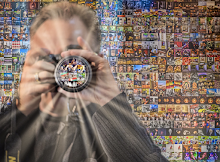EXPERIMENTS IN PERCEPTION
(Or, What does this have to do with photography?)
Reimagine the present as the past. How would your POV change, or would it? Compare the wonder of early 1800’s images, and even the first known photos, to the absolutist images of today, and explore the sense of wonder and imagination from both points of view.
Consider our notions of a “throwaway society” in terms of photography and what we today deem worthy of exhibiting compared to how we appreciate imperfect images from the past. How does that comparison square with our personal and collective ideals of worthiness and value of any given photo?
Can we learn value and appreciation of beauty, history, and our surroundings by exploring and reconsidering the “throwaway” components of our efforts to capture the “perfect” photo?
As photography enthusiasts, are we too quick to judge images as throwaways or duds due to the evolution of photographic tools and our modern expectations for results we can achieve with those tools, and does that dampen our ability to see beyond imperfection, thus narrowing the definitions of art and beauty? Do imperfections in any given photo enhance its intrinsic beauty or appeal? How does the often touted benefits of large megapixel capabilities of our modern, ever evolving photo equipment and software reduce our ability to see beauty and worth in mundane or lower quality images?
Does the use of present-day editing software to create imperfections in already imperfect images defeat the purpose of said software?
The oldest known surviving photograph titled “View From the Window at Le Gras” was taken around 1826 by Nicephore Niepce using his photographic invention called heliography. That process created a one-of-a kind photo on a pewter plate treated with bitumen of Judea which is a naturally occurring asphalt containing light-sensitive properties. The photo was a grainy, blurred, purple tinted rendering of buildings that are barely recognizable as buildings. This photo is sometimes shown as a Helumt Gershein enhanced version that belies the primitive nature of the original photo taken by Niepce. The original is currently part of the permanent collection at the University of Texas-Austin.
The Niepce image is often regarded with awe by photogs and the general public despite its mostly unrecognizable content.
Combing through my old files of photos, I’ve been looking at the images that would nearly always be considered as throwaways or duds. I’ve edited these photos from an “ancient” point of view, imagining them as the early primitive art form of photography, and also viewing them from a modern stance of abstract imaging. Few people like or appreciate blurry, grainy, abstract photos, and the common refrain might be, “What the hell is THAT? I just don’t get it!” Others will glibly ask the rhetorical question, “What does this have to do with photography?”
Thus, when asking the question, “What does this have to do with photography,” try to understand how your preconceived expectations of photography determine what you consider as beauty, art, or perfection. Next, ask yourself if that answer might be the the same for every other viewer of photography. Remember that any given image will elicit a thousand reactions from a hundred people. From simple images of street signs to the esoteric renderings with blur, grain, and abstract qualities, every photograph is photography. Not every photo can be described as “fine art” photography, but anyone who has to ask the question of, “What does this have to do with photography” should reevaluate their use of imagination, curiosity, and even humor. Having to ask that question suggests more about the one asking, than the photo itself.
I encourage photography enthusiasts to break out of their insular views and habits, and explore different avenues of the hobby and art. Re-imagine the images you’ve passed by or rejected, and engage in experiments of perception. Imagination breathes new life into a hobby, and might lead to fun and exciting directions, despite some people who “just don’t get art,” or who’s perceptions are blurred in the ruts of habit and dogma.
©Rick Burnett Baker














Thank you for consistently delivering content that resonates with me.
ReplyDeleteThank YOU!
DeleteMy family life has changed for good ever since my colleagues introduce Dr Jekawo to my family, Dr Jekawo cure my dad from Parkinson, cure my herpes and HPV, also cure my husband diabetes with his herbal medicines that he sent to us via courier service then Dr Jekawo instruct us how to drink the herbal medicines and today we are all well healthy so I want to express my gratitude to Dr Jekawo for his ancestral gift to able to cure all diseases with his herbal Medicines'd Itua is a traditional herbal doctor that reside in west Africa also Dr Jekawo cure diseases like ALS,Diabetes,HPV,HSV,Hiv/Aids,Cancer,Hepatitis,Bring Ex Back,Bronchitis,Chronic Disease,Degenerative diseases. Contact Dr Jekawo Email: drjekawo@gmail.com He's a good herbal doctor with a listen and trusted heart.
ReplyDelete